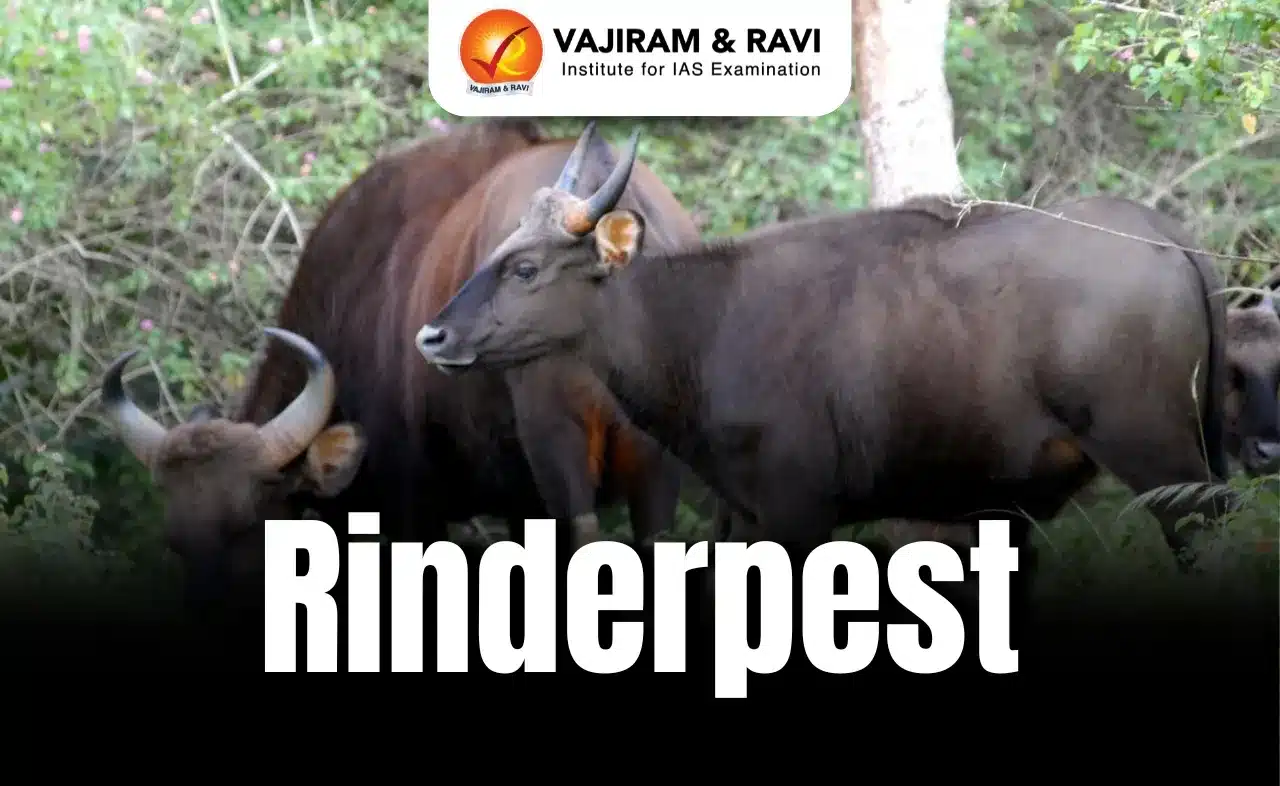Rinderpest Latest News
India has secured a prestigious position in global animal health with the designation of the ICAR-National Institute of High Security Animal Diseases (NIHSAD) in Bhopal as a Category A Rinderpest Holding Facility (RHF).
About Rinderpest
- It is also known as cattle plague, is a contagious viral disease affecting clovenhoofed animals (mainly cattle and buffalo).
- It is caused by a virus of the Paramyxoviridae family, genus Morbillivirus.
- Many species of wild and domestic cloven-hoofed animals (including sheep and goats) show only mild symptoms of the disease when infected, but for cattle and buffalo, mortality rates can reach up to 100 per cent in highly susceptible herds.
- Other than cattle and buffalo, rinderpest can infect zebus, water buffaloes, African buffaloes, eland, kudu, wildebeest, various antelopes, bushpigs, warthogs, giraffes.
Transmission of Rinderpest
- It is spread by effective contact between animals carrying the virus and susceptible animals. The virus is found in nasal secretions a few days before any clinical signs appear.
- As the disease progresses the virus is found in most body fluids and either death ensues, or the animal recovers, develops immunity and clears the virus from the body.
Symptoms of Rinderpest
- In cattle, signs of the disease include fever, erosive lesions in the mouth, discharge from the nose and eyes, profuse diarrhoea and dehydration, often leading to death within 10 to 15 days.
- In other species rinderpest may show milder clinical signs.
- There is no public health risk, since rinderpest does not affect people.
- It historically occurred in Europe, Africa and Asia.
- In 2011 this disease was officially eradicated.
Designation of Rinderpest Holding Facility
- It is given by the World Organisation for Animal Health (WOAH) and the United Nations’ Food and Agriculture Organization (FAO).
- To prevent its re-emergence, WOAH and FAO restrict the storage of Rinderpest Virus-Containing Material (RVCM) to a select few high-security laboratories worldwide.
- ICAR-NIHSAD, a Biosafety Level-3 (BSL-3) facility and WOAH reference laboratory for avian influenza, was designated as India’s RVCM repository in 2012.
- Following a rigorous evaluation the institute earned Category A RHF status for one year.
- This recognition places India among a distinguished group of only six facilities worldwide entrusted with the critical responsibility of securely holding rinderpest virus material.
Source: PIB
Last updated on December, 2025
→ Check out the latest UPSC Syllabus 2026 here.
→ Join Vajiram & Ravi’s Interview Guidance Programme for expert help to crack your final UPSC stage.
→ UPSC Mains Result 2025 is now out.
→ UPSC Notification 2026 is scheduled to be released on January 14, 2026.
→ UPSC Calendar 2026 is released on 15th May, 2025.
→ The UPSC Vacancy 2025 were released 1129, out of which 979 were for UPSC CSE and remaining 150 are for UPSC IFoS.
→ UPSC Prelims 2026 will be conducted on 24th May, 2026 & UPSC Mains 2026 will be conducted on 21st August 2026.
→ The UPSC Selection Process is of 3 stages-Prelims, Mains and Interview.
→ UPSC Result 2024 is released with latest UPSC Marksheet 2024. Check Now!
→ UPSC Prelims Result 2025 is out now for the CSE held on 25 May 2025.
→ UPSC Toppers List 2024 is released now. Shakti Dubey is UPSC AIR 1 2024 Topper.
→ UPSC Prelims Question Paper 2025 and Unofficial Prelims Answer Key 2025 are available now.
→ UPSC Mains Question Paper 2025 is out for Essay, GS 1, 2, 3 & GS 4.
→ UPSC Mains Indian Language Question Paper 2025 is now out.
→ UPSC Mains Optional Question Paper 2025 is now out.
→ Also check Best IAS Coaching in Delhi
Rinderpest
Q1. What is the disease blue tongue?+
Q2. What does World Organisation for Animal Health (WOAH) do?+
Tags: prelims pointers rinderpest upsc current affairs upsc prelims current affairs

















